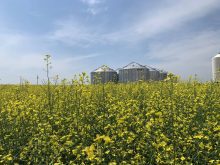Evidence so far suggests a new canola seed pelleting technology from Syngenta will help growers limit misses and double- or triple-hits in seed placement.
According to industry professional Lori Keyowski, director of sales for seed company Canterra, seed size and uniformity have been a significant problem for canola growers and their bottom line.
In early May, Syngenta Canada launched a new seed pelleting technology called Pelta, which is expected to help optimize seeds for an overall improvement in singulation planter performance.
Read Also

Claas brings 1000 Series SP forage harvesters to Canada
In mid-August, Claas unveiled its new line of Jaguar forage harvesters at an event in Visalia, California, deep in the heart of that state’s dairy region.
“Canola is one of the most important and profitable crops in the Prairies, but often comes with high upfront input costs,” explains Karen Ullman, seedcare product lead with Syngenta Canada. “That’s why it’s so important for growers to get the full genetic potential out of every seed.”
Syngenta, in a recent release, sats the new technology will help reduce the risk of “guesswork” involved with seeding canola.
“With Pelta, with the coating ability, it ensures that each seed inside that bag is going to be exactly the same size,” Keyowski says. “So, the reel is going to pick it up at the same rate and place it at the same rate every time, essentially.”
A Syngenta Canada representative said via email the company believes Pelta will be able to make seeds more uniform, which in turn will improve factors such as the survivability of the seed, removing the chance of double- or triple-planting — and the increased accuracy of seeding means the emergence of plants will be more uniform and they won’t have to compete for resources.
Keyowski says the company didn’t have data from this growing season as of mid-August, but Canterra worked with a few co-operators in Alberta last season who were able to use Pelta before its commercial release.
“In quotations of that farmer, he said ‘he had over 20 per cent return with the Pelta technology.’ Now, in a month and a bit time here, we’ll have a lot more data coming off this fall to, you know, validate those results.”
Keyowski also described how Pelta could be useful in drought conditions because the coating itself is hydrophilic, so it will absorb the maximum amount of water possible.
Pelta was offered through Canterra for the 2022 season and will remain the same in 2023.
Syngenta offers Pelta with three different canola hybrids, but would not disclose the exact price of the new technology.















